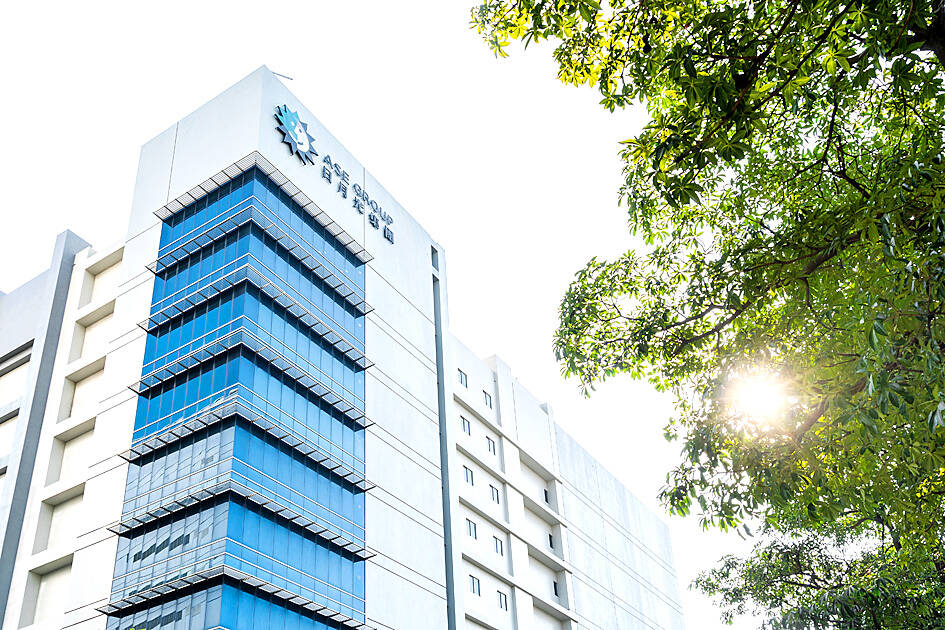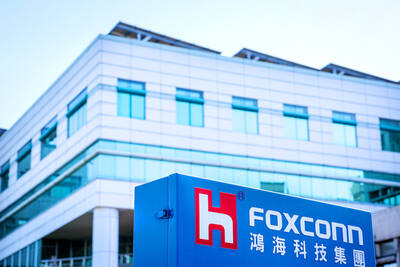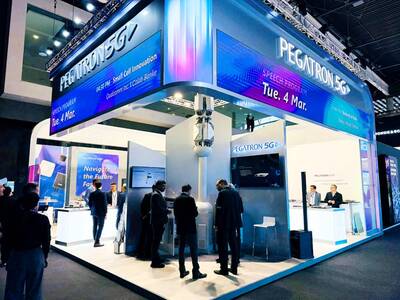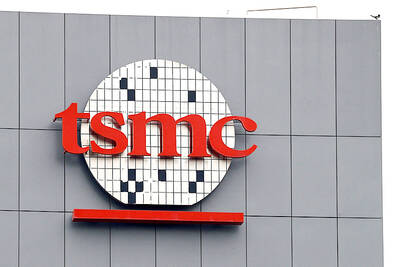ASE Technology Holding Co (日月光投控), the world’s biggest chip assembly and testing manufacturing (ATM) service provider, yesterday said revenue from its leading-edge packaging and testing services would more than double to US$1.6 billion this year, thanks to accelerating adoption of artificial intelligence (AI) technology spreading to edge devices.
That compared with US$600 million last year and US$250 million in 2023 from advanced packaging and testing services, the Kaohsiung-based company told an investors’ conference.
ASE said that non-AI applications this year have adopted advanced packaging technology similar to the chip-on-wafer-on-substrate (CoWoS) technology.

Photo: Grace Hung, Taipei Times
CoWoS is primarily used in packaging Nvidia Corp’s AI chips made by Taiwan Semiconductor Manufacturing Co (TSMC, 台積電).
This year, ASE’s ATM revenue would extend the robust growth of last year, the company said.
The global semiconductor market, excluding the memory chip market, is forecast to grow about 13 percent annually this year, International Data Corp said.
ASE said the forecast did not include the “potential upside” from increased demand from Chinese customers as a result of new semiconductor restrictions imposed by the US Bureau of Industry and Security (BIS).
“We are trying to understand the detailed execution, the rules and also the capacity requirement,” ASE chief operating officer Tien Wu (吳田玉) said.
“We do understand this is an upside and we are aggressively working with our foundry partner and customers to try to fulfill that demand,” Tien said.
Based on the BIS regulations, TSMC is banned from shipping 14-nanometer or 16-nanometer chips to China, unless the chips are packaged and tested by entities approved by the bureau.
Overall, ASE believes this year would be “decent” for the company.
“We will continue to accelerate in preparation for the AI-led supercycle, which we believe started in 2024 and we will see the momentum in 2025, 2026 and beyond,” Wu said.
To cope with growing demand, ASE plans to spend US$2 billion on new manufacturing equipment and facilities this year in Taiwan and overseas, up from US$1.9 billion last year.
Despite the increased capital expenditure, ASE would still improve its gross margin, chief financial officer Joseph Tung (董宏思) said.
The gross margin of its ATM business this year would rise to 24 to 30 percent from 22.5 percent last year, Tung said.
Further improvement is expected next year, he added.
ASE’s net profit last year increased 2 percent to NT$32.48 billion (US$990.18 million), compared with NT$31.73 billion in 2023. Earnings per share rose to NT$7.52 from NT$7.39 a year earlier.
ASE said that it expects ATM revenue this quarter to decline by a single-digit percent sequentially from NT$88.38 billion, while gross margin is to drop by 1 percentage point from 23.3 percent last quarter.
It expects high-performance computing to show the strongest growth momentum this quarter, Tung said.
The communications segment is picking up faster than other segments, while the automotive segment is in the process of recovery, he said.
On the electronic manufacturing service (EMS) side, revenue is to drop slightly year-on-year from NT$59.33 billion a year earlier, ASE said.
Operating profit margin is projected to slide 0.3 percentage points from 2.8 percent the previous year, it added.

Hon Hai Precision Industry Co (鴻海精密) yesterday said that its research institute has launched its first advanced artificial intelligence (AI) large language model (LLM) using traditional Chinese, with technology assistance from Nvidia Corp. Hon Hai, also known as Foxconn Technology Group (富士康科技集團), said the LLM, FoxBrain, is expected to improve its data analysis capabilities for smart manufacturing, and electric vehicle and smart city development. An LLM is a type of AI trained on vast amounts of text data and uses deep learning techniques, particularly neural networks, to process and generate language. They are essential for building and improving AI-powered servers. Nvidia provided assistance

STILL HOPEFUL: Delayed payment of NT$5.35 billion from an Indian server client sent its earnings plunging last year, but the firm expects a gradual pickup ahead Asustek Computer Inc (華碩), the world’s No. 5 PC vendor, yesterday reported an 87 percent slump in net profit for last year, dragged by a massive overdue payment from an Indian cloud service provider. The Indian customer has delayed payment totaling NT$5.35 billion (US$162.7 million), Asustek chief financial officer Nick Wu (吳長榮) told an online earnings conference. Asustek shipped servers to India between April and June last year. The customer told Asustek that it is launching multiple fundraising projects and expected to repay the debt in the short term, Wu said. The Indian customer accounted for less than 10 percent to Asustek’s

‘DECENT RESULTS’: The company said it is confident thanks to an improving world economy and uptakes in new wireless and AI technologies, despite US uncertainty Pegatron Corp (和碩) yesterday said it plans to build a new server manufacturing factory in the US this year to address US President Donald Trump’s new tariff policy. That would be the second server production base for Pegatron in addition to the existing facilities in Taoyuan, the iPhone assembler said. Servers are one of the new businesses Pegatron has explored in recent years to develop a more balanced product lineup. “We aim to provide our services from a location in the vicinity of our customers,” Pegatron president and chief executive officer Gary Cheng (鄭光治) told an online earnings conference yesterday. “We

LEAK SOURCE? There would be concern over the possibility of tech leaks if TSMC were to form a joint venture to operate Intel’s factories, an analyst said Taiwan Semiconductor Manufacturing Co (TSMC, 台積電) yesterday stayed mum after a report said that the chipmaker has pitched chip designers Nvidia Corp, Advanced Micro Devices Inc and Broadcom Inc about taking a stake in a joint venture to operate Intel Corp’s factories. Industry sources told the Central News Agency (CNA) that the possibility of TSMC proposing to operate Intel’s wafer fabs is low, as the Taiwanese chipmaker has always focused on its core business. There is also concern over possible technology leaks if TSMC were to form a joint venture to operate Intel’s factories, Concord Securities Co (康和證券) analyst Kerry Huang (黃志祺)